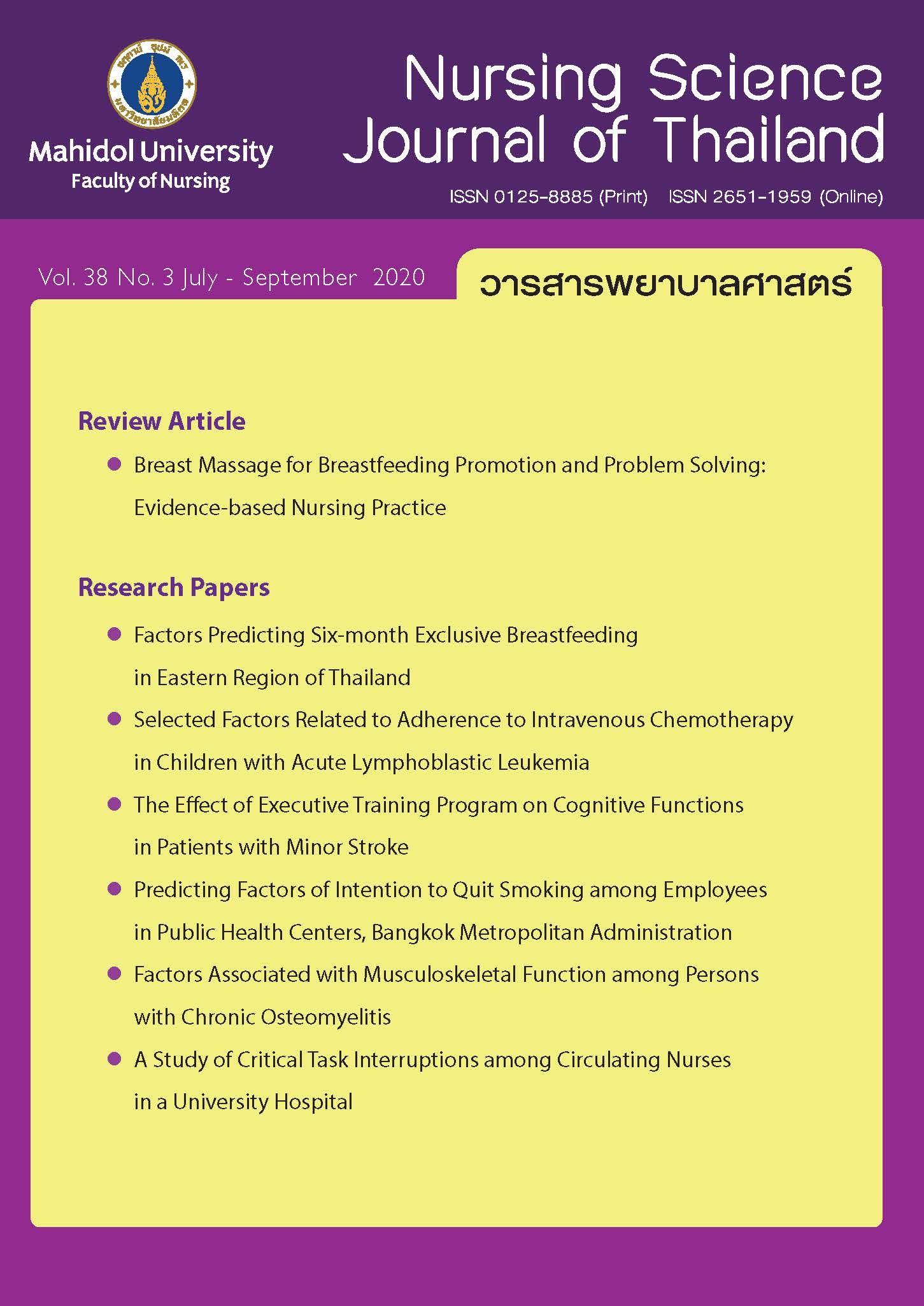A Study of Critical Task Interruptions among Circulating Nurses in a University Hospital
Main Article Content
Abstract
Purpose: The purposes of this study were to identify frequency and sources of interruptions in the operating room, and to compare average of interruption occurrence in each level of the interruption effects among different types of surgery and different years of working experience.
Design: Descriptive study.
Methods: Ninety-nine circulating nurses performing critical tasks in 1) head neck breast 2) gastro-intestinal and abdomen 3) urological and 4) orthopedic surgeries were observed regarding the frequency and sources of interruptions of circulating nurses’ role at a university hospital in Thailand using the Interruptions Rating Scale. Data were analyzed by using descriptive statistics and Kruskal Wallis test and Mann Whitney U.
Main findings: Results from the observation on circulating nurses performing critical tasks in ninety-nine surgeries showed that mean intraoperative duration was 155.1 minutes (SD = 77.2). Most of them were female (86.9%) with mean age of 41.1 years (SD = 9.69); 56.6% were registered nurses and 43.4% practical nurses. Overall, 446 intraoperative interruptions were observed during 3 critical tasks. The most frequent sources of distractions and interruptions were people entering/exiting room (153 times, 34.3%), phone/radio/beeper (118 times, 26.45%), irrelevant communication (72 times, 16.14%). Data indicated that nurses with more working experience (>10 years) were more likely to be distracted and interrupted by case irrelevant communication than those with less experience (≤ 10 years) (p = .033).
Conclusion and recommendations: This study shows high interruptions during critical tasks in operating rooms. This study provides evidence of the need of developing guidelines/work instruction to minimize unnecessary interruptions during critical task procedures in operating rooms. Moreover, education and training for circulating nurses in operating rooms regarding handles interruptions in the safety manner are also needed.
Article Details
Copyright Notice: Nursing Science Journal of Thailand has exclusive rights to publish and distribute the manuscript and all contents therein. Without the journal’s permission, the dissemination of the manuscript in another journal or online, and the reproduction of the manuscript for non-educational purpose are prohibited.

Disclaimer: The opinion expressed and figures provided in this journal, NSJT, are the sole responsibility of the authors. The editorial board bears no responsibility in this regard.
References
Sevdalis N, Forrest D, Undre S, Darzi A, Vincent C. Annoyances, disruptions, and interruptions in surgery: the Disruptions in Surgery Index (DiSI). World J Surg. 2008;32(8):1643-50. doi: 10.1007/s00268-008-9624-7.
Fencl JL. Guideline implementation: prevention of retained surgical items. AORN J. 2016;104(1):37-48. doi: 10.1016/j.aorn.2016.05.005.
Baethge A, Rigotti T. Interruptions to workflow: their relationship with irritation and satisfaction with performance, and the mediating roles of time pressure and mental demands. Work Stress. 2013;27(1):43-63. doi: 10.1080/02678373.2013.761783.
Bennett J, Dawoud D, Maben J. Effects of interruptions to nurses during medication administration. Nurs Manag (Harrow). 2010;16(9):22–3. doi: 10.7748/nm2010.02.16.9.22.c7522.
Hickam DH, Severance S, Feldstein A, Ray L, Gorman P, Schuldheis S, et al. The effect of health care working conditions on patient safety. Evid Rep Technol Assess (Summ). 2003;(74):1-3.
Zheng B, Martinec DV, Cassera MA, Swanström LL. A quantitative study of disruption in the operating room during laparoscopic antireflux surgery. Surg Endosc. 2008;22(10):2171-7. doi: 10.1007/s00464-008-0017-7.
Trbovich P, Prakash V, Stewart J, Trip K, Savage P. Interruptions during the delivery of high-risk medications. J Nurs Adm. 2010;40(5):211-8. doi: 10.1097/NNA.0b013e3181da4047.
Westbrook JI, Coiera E, Dunsmuir WTM, Brown BM, Kelk N, Paoloni R, et al. The impact of interruptions on clinical task completion. Qual Saf Health Care. 2010;19(4):284-9. doi: 10.1136/qshc.2009.039255.
Healey AN, Sevdalis N, Vincent CA. Measuring intra-operative interference from distraction and interruption observed in the operating theatre. Ergonomics. 2006;49(5-6):589-604. doi: 10.1080/00140130600568899.
Brixey JJ, Tang Z, Robinson DJ, Johnson CW, Johnson TR, Turley JP, et al. Interruptions in a level one trauma center: a case study. Int J Med Inform. 2008;77(4):235-41. doi: 10.1016/j.ijmedinf.2007.04.006.
Healey AN, Primus CP, Koutantji M. Quantifying distraction and interruption in urological surgery. Qual Saf Health Care. 2007;16(2):135-9. doi: 10.1136/qshc.2006.019711.
Vincent C. Patient safety. 2nd ed. Chichester, UK: John Wiley & Sons; 2010. 416 p.
The Healthcare Accreditation Institute [Internet]. Nonthaburi: The Healthcare Accreditation Institute; c2015 [cited 2020 Jun 5]. Available from: https://www.ha.or.th/TH/Home.
Spruce L. Back to basics: implementing evidence‐based practice. AORN J. 2015;101(1):106-12; quiz 113-114.e4. doi: 10.1016/j.aorn.2014.08.009.
Getnet MA, Bifftu BB. Work interruption experienced by nurses during medication administration process and associated factors, Northwest Ethiopia. Nurs Res Pract. 2017;2017:8937490. doi: 10.1155/2017/8937490.
Gillespie BM, Chaboyer W, Fairweather N. Interruptions and miscommunications in surgery: an observational study. AORN J. 2012;95(5):576-90. doi: 10.1016/j.aorn.2012.02.012.
Cohen J. Statistical power analysis for the behavioral sciences. 2nd ed. Mahwah, NJ: Lawrence Erlbaum Associates; 1988. 527 p.
Waltz CF, Strickland OL, Lenz ER. Measurement in nursing and health research. New York: Springer Publishing; 2010. 477 p.
Antoniadis S, Passauer-Baierl S, Baschnegger H, Weigl M. Identification and interference of intraoperative distractions and interruptions in operating rooms. J Surg Res. 2014;188(1):21-9. doi: 10.1016/j.jss.2013.12.002.
Monsell S. Task switching. Trends Cogn Sci. 2003;7(3):134-40. doi: 10.1016/s1364-6613(03)00028-7.
Sirihorachai R, Aebersold ML, Sarter NB, Harris M, Marsh V, Redman RW. Examining interruptions in the operating room using simulation. Clin Simul Nurs. 2018;24:14-24. doi: 10.1016/j.ecns.2018.08.004.


